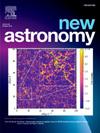Insights from modelling magnetar-driven light curves of stripped-envelope supernovae
IF 2.1
4区 物理与天体物理
Q2 ASTRONOMY & ASTROPHYSICS
引用次数: 0
Abstract
This work presents the semi-analytical light curve modelling results of 11 stripped-envelope SNe (SESNe), where millisecond magnetars potentially drive their light curves. The light-curve modelling is performed utilizing the -minimization code MINIM considering millisecond magnetar as a central engine powering source. The magnetar model well regenerates the bolometric light curves of all the SESNe in the sample and constrains numerous physical parameters, including magnetar’s initial spin period () and magnetic field (), explosion energy of supernova (), progenitor radius (), etc. Within the sample, the superluminous SNe 2010kd and 2020ank exhibit the lowest and values, while the relativistic Ic broad-line SN 2012ap shows the highest values for both parameters. The explosion energy for all SESNe in the sample (except SN 2019cad), exceeding 2 × 1051 erg, indicates there is a possibility of a jittering jet explosion mechanism driving these events. Additionally, a correlation analysis identifies linear dependencies among parameters derived from light curve analysis, revealing positive correlations between rise and decay times, and , and , and and , as well as strong anti-correlations of and with the peak luminosity. Principal Component Analysis is also applied to key parameters to reduce dimensionality, allowing a clearer visualization of SESNe distribution in a lower-dimensional space. This approach highlights the diversity in SESNe characteristics, underscoring unique physical properties and behaviour across different events in the sample. This study motivates further study on a more extended sample of SESNe to look for millisecond magnetars as their powering source.
从模拟剥离包膜超新星的磁驱动光曲线的见解
这项工作提出了11个剥离包络snne (SESNe)的半解析光曲线建模结果,其中毫秒磁星可能驱动其光曲线。利用χ2最小化代码MINIM进行光曲线建模,考虑毫秒磁星作为中心引擎动力源。磁星模型很好地再现了样品中所有SESNe的热光度曲线,并约束了许多物理参数,包括磁星的初始自旋周期(Pi)和磁场(B)、超新星爆炸能量(exp)、祖星半径(Rp)等。在样品中,超亮SNe 2010kd和2020ank的B和Pi值最低,而相对论Ic宽线SN 2012ap的B和Pi值最高。除SN 2019cad外,样品中所有SESNe的爆炸能量均超过了约2 × 1051 erg,表明可能存在抖动射流爆炸机制驱动这些事件。此外,相关分析确定了光曲线分析得出的参数之间的线性依赖关系,揭示了上升和衰减时间、Pi和B、Pi和Rp、exp和Rp之间的正相关关系,以及Pi和B与峰值亮度的强反相关关系。主成分分析还应用于关键参数,以降低维数,使SESNe分布在低维空间中更加清晰可视化。这种方法强调了SESNe特征的多样性,强调了样本中不同事件的独特物理性质和行为。这项研究激发了对更广泛的SESNe样本的进一步研究,以寻找毫秒磁星作为它们的动力来源。
本文章由计算机程序翻译,如有差异,请以英文原文为准。
求助全文
约1分钟内获得全文
求助全文
来源期刊

New Astronomy
地学天文-天文与天体物理
CiteScore
4.00
自引率
10.00%
发文量
109
审稿时长
13.6 weeks
期刊介绍:
New Astronomy publishes articles in all fields of astronomy and astrophysics, with a particular focus on computational astronomy: mathematical and astronomy techniques and methodology, simulations, modelling and numerical results and computational techniques in instrumentation.
New Astronomy includes full length research articles and review articles. The journal covers solar, stellar, galactic and extragalactic astronomy and astrophysics. It reports on original research in all wavelength bands, ranging from radio to gamma-ray.
 求助内容:
求助内容: 应助结果提醒方式:
应助结果提醒方式:


